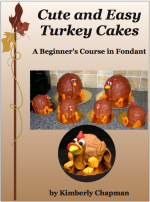Or maybe the first. Probably somewhere in between. It was either that or a Futurama joke and I do try to keep this blog family-friendly.
Anyway.
COOKIE BENDING!
A friend on G+ challenged me to make a bent-clock cookie as seen in Dali’s famous piece The Persistence of Memory. I Googled around to see if anyone else had made such a thing and found that the Dali Museum apparently sells two-dimensional bent-clock cookies, but that was all I could find.
So I made one:

Chocolate cookie with fondant painted with food gel and edible ink marker.
The decorating wasn’t any particular challenge, but to get the cookie to bake bent – plus unbroken and stable for decorating – took some experimentation.
I was making some of my favourite rolled chocolate cookie dough for some facehugger and sonic screwdriver cookies for friends anyway, so I decided to experiment with some extra dough.
At first I thought I’d hang the cookies to bake with the hopeful result that they’d hang of their own accord after decorating. But I wasn’t sure if the dough would move too much, so I ran some tests.
I cut some ovals out of the dough and hung them on a flour-sprayed inverted cake pan:

I tried to support them up against the rolled lip of the pan. It felt stable while cold, but I could already tell they would probably shift at least a little during cooking.
In short order, though, it became apparent that there was going to be a weak spot at the bend:

Sure, that crack would be covered by the fondant I planned to put on top, but weakness is never good in cookie construction, even when hidden.
Thus, even though I already had doubts about this working I knew people would inevitably ask, “Have you tried…” so I persisted. With memory. See what I did there? Heh. Yeah. Ahem. Anyway.
I tried adding extra material to the bend point and put that cookie on the pan along with the other two regular ones.

I was already anticipating failure as a meaningful result at this point. Science works whether you want it to or not.
Annnnnnd…yup, there’s the negative result as anticipated:

Cue the sad trombones.

This is the one I added extra material to, which you can see just weighed it down more.
But as Adam Savage so wisely said, “Failure is always an option.” It’s important, because it gives us data. And what do we do here at Eat the Evidence when we have an aesthetic failure of a tasty baked good?

That’s right, Cookie. We Eat the Evidence, nom nom eye-wiggle nom. Image from here. Intended for parody/educational purposes only. Don’t sue me…all I’ve got is a stale Dali cookie in my cabinet. Plus I’m a sustaining PBS member so that surely counts for something, right?
In fact, since one of them actually came off the pan intact, it at least gave me hope that cookie bending was plausible by some other method.

Yes, my daughter and I ate this. And the broken bits of the other two. And we scraped the delicious crumbs out of the cake pan’s rim and ate those too. Don’t judge us. What? Nothing. Yes.
Next I thought I’d try the Simi Flex Form Molds I had just been reviewing for use with gummy. I thought maybe if I could use some foil to hold the ends in place, I could somehow curve the strip under the cookie and hold it up during baking like an underwire. But just like underwires, this proved to be a hassle-prone idea because the flex form just didn’t want to stay in place, especially once it got slick with the flour spray:

This is why I don’t post videos to this blog very often, because the language I was using with this all flopping around all over the place was decidedly not family-friendly.
To be fair, the flex forms were not made with this in mind so this is not in any way a strike against them. I was just trying to see if I could repurpose them for something else.
I bailed on the idea of using an inverted cake pan entirely and decided instead to try a muffin pan. I rigged up one cookie with no spray and one cookie with spray. I knew the top end would sag into the other cup, but figured this was worth a proof-of-concept try anyway.

I thought maybe being bumped up against the bottom of the cup would stop the dough from going too far. I have had success in making hollow-sphere cookies before (oh yeah, I should probably post that since I promised to um…a year ago…heh…), so this was at least plausible.
If this had worked, I’d have done it again with foil or something in the other cup to hold the top edge up. But as shown below, it didn’t work. The sprayed side was a particularly bad result:

Oh the cookianity!

This side isn’t horrible and may have been made to work with some support for the top edge, except that it was really, really hard to get off in one piece. I don’t like posting instructions for other folks that are likely to make people frustrated, so while this had promise, it still was not an acceptable methodology for cookie bending.

Mind you, it did look kind of nifty when it came off, and was reasonably stable like this.
The time had come to realize that hanging it to bake just wasn’t going to work. I needed to prop it up face-down, meaning the interior corner would puff out and not be well-suited for actual hanging against a cornered edge, but at least I could get a stable bent cookie out of it.
So I cut another couple of ovals and propped them up against a silicone mini pan I won as a door prize and haven’t used for much else other than making a big candy star for a holiday cake:

I made sure to push them up against the little pan firmly for as much of a bent edge as possible. At this point I was reasonably sure this would work, since I’ve had cookies come out slightly curved from parchment paper bumped up on pan edges.
Sure enough, this worked:

Bent cookies! Hurrah! Be sure not to remove the support until they’ve cooled, though, or else the hot, tender dough will just slump over. But once cool, these are pretty strong in this shape.
It sat around waiting to be decorated for several days because I was so busy with other projects. But eventually I got around to rolling and cutting some white fondant in the melted shape of the Dali clock and applying that to the cookie with some water and corn syrup. I then made a very dilute mixture of water and blue food gel and painted it on to look as close to the original painting as possible. I let that dry for nearly 24 hours to be sure it was completely dry.
Next I made the markings for the clock and wrote on the numbers. I then rolled a long snake of yellow and wrapped it around, pushing it gently to overlap the face edge, fixing it in place with corn syrup and water. I sculpted the teeny tiny bee and teeny tiny hands, then added the top knob and voila, a Dali-inspired actually-bent melted-clock cookie:

Side view so you can see the bend. The colour jar used for support is the one I used for the painting. I usually prefer Americolor gels but I still have some of these Wilton ones around from my early decorating days, and in this case I wanted a more dilute color so Wilton is better for that.

View from the other side so you can see the bee better. Note how I indented the yellow border more harshly in some places to accentuate the wobbly-melty design. The timey-wimey-ness, if you will. And if you clicked the link above to the sonic screwdriver cookies, I know you will.

The back side, where you can see that the dough has pinched itself so while it’s strong enough, it won’t sit flush against a corner.
There you have it. You can bend cookies, as long as the recipe allows for it and you have it fully supported. Some doughs turn almost to liquid during baking (which is why they spread so far) and thus may not work as well as more stable doughs. I happen to know that this chocolate dough doesn’t spread so much, which is why I keep pushing it beyond sensible limits. If you want to make a bent cookie, be sure to test your preferred recipes in advance. You will likely not have trouble finding an audience to help you eat your evidence!












“What? My name is Bender. I’m a bending unit. Of course I like to bend things.” *Bender bends the cookie*
…And I think that’s about the only family-friendly Bender joke you’re going to get.
This is a really awesome idea. I’m guessing that multi-cookie 3D art relies on strong icing to hold it all together? Because I can’t see myself, say, turning the mold inside-out and making a 3D cookie star box.
Yes, those really cool 3D displays are more akin to gingerbread houses in their basic construction methods.
A star cookie box would actually not be that hard via a gingerbread-iced method, but I don't know of any way to do that as a single piece with a cookie short of having some kind of bakeable mold that contains the pressure of the expanding cookie dough yet also releases easily.
Some friends and I have been joking that we should try that hideous looking Rollie Egg machine to see if we could use it to make cookies on a stick. However, I suspect it wouldn't cook them properly so the result would be more cookies on a sick. XD
When I make Parmesan crisps I sometimes cool them into shape. I hadn't thought of baking them in shape. Thanks now I'll probably have less burned fingers.